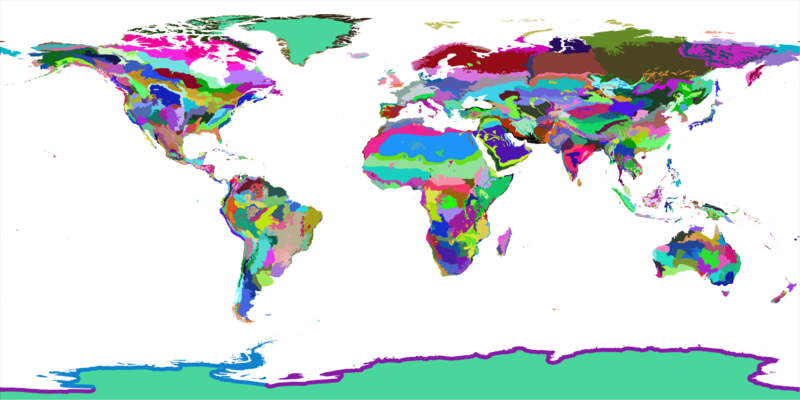Ecoregion
Ecoregion is an originally geoscientific term for the division of the earth into large areas under different geo- or bio- ecological aspects. In this sense, it was defined as a "recurring pattern of ecosystems that are associated with characteristic combinations of soil and terrain and that characterize a region."
The term “ biome ”, which is more strongly influenced by life sciences , shows a very great similarity in content to ecoregion and is therefore often used synonymously today. The same applies to the geozonal derivatives “zonobiom”.
Demarcation
An ecoregion is the next smaller unit below the ecozone or other biogeographical models . Ecoregions encompass relatively large areas of land or water and contain distinctive plant and animal communities. In contrast to the ecozone, however, its extension is not geozonal (encompassing the earth), but regionally limited.
An ecoregion refers to regional types of vegetation that are named solely for their predominant plant formation - i.e. their external appearance (tundra of Western Siberia, desert vegetation of the Middle East, etc.) . This makes the ecoregion synonymous with the EU biome. In contrast to this, the term ecoregion is sometimes used to denote regional flora or fauna regions . Such regions do not result from their external appearance, but from a common geological development (Central Siberian tundra, Central Asian North Desert, etc.) , which is expressed in their species inventory. Occasionally the floristic / faunistic and the formative approach are combined to identify ecoregions. This is of particular interest for nature conservation reasons.
Colloquially, the term ecoregion is often used in a rather undifferentiated manner for all possible biological-geographical classifications. In the English-speaking world, the term “Ecozones” is sometimes used synonymously with “Ecoregions” and both for continentally limited “Ecoregions” and partly for the global ecozones.
WWF ecoregions
The environmental foundation WWF USA has made an exemplary worldwide division into 825 terrestrial “ecoregions”, which in this model subdivide 14 “major habitat types” (main biomes ). In 2000, WWF employees published a presentation of 200 particularly endangered ecoregions under the title “Global 200”. In addition, limnic and marine ecoregions and ecozones were identified according to similar criteria . This was a new approach because previously the concept of biomes had been applied almost exclusively to terrestrial areas of the ecosphere. Worldwide, 426 ecoregions of fresh water and 232 ecoregions of seawater were determined in 12 realms . Deep sea ecoregions could not yet be taken into account.
See also
Web links
- Terrestrial Ecoregions of the WWF (English)
- WWF "Wildfinder", interactive map of the Ecozones (English)
- The WWF "Global 200" ecoregions
Individual evidence
- ^ D. Brunckhorst: Bioregional planning: resource management beyond the new millennium. Harwood Academic Publishers, Sydney, Australia 2000.
- ↑ DM Olson, E. Dinerstein, E. Wikramanayake, N. Burgess, G. Powell, EC Underwood, J. d'Amico, I. Itoua, H. Strand, J. Morrison, C. Loucks, T. Allnutt, TH Ricketts, Y. Kura, W. Wettengel, K. Kassem: Terrestrial Ecoregions of the World: A New Map of Life on Earth. In: BioScience. 51, 2001, pp. 933-938, doi : 10.1641 / 0006-3568 (2001) 051 [0933: TEOTWA] 2.0.CO; 2 (pdf)
- ^ A. Longhurst: Ecological Geography of the Sea . San Diego, 1998, ISBN 0-12-455558-6 .
- Jump up ↑ R. Abell, ML Thieme, C. Revenga, M. Bryer, M. Kottelat, N. Bogutskaya, B. Coad, N. Mandrak, S. Contreras Balderas, W. Bussing, MLJ Stiassny, P. Skelton, GR Allen , P. Unmack, A. Naseka, R. Ng, N. Sindorf, J. Robertson, E. Armijo, JV Higgins, TJ Heibel, E. Wikramanayake, D. Olson, HL López, RE Reis, JG Lundberg, MH Sabaj Pérez, P. Petry: Freshwater Ecoregions of the World: A New Map of Biogeographic Units for Freshwater Biodiversity Conservation. In: BioScience. 58, 2008, pp. 403–414, doi: 10.1641 / B580507 (pdf)
- ↑ MD Spalding, HE Fox, GR Allen, N. Davidson, ZA Ferdana, M. Finlayson, BS Halpern, MA Jorge, A. Lombana, SA Lourie, KD Martin, E. McManus, J. Molnar, CA Recchia, J. Robertson: Marine Ecoregions of the World: A Bioregionalization of Coastal and Shelf Areas. In: BioScience. 57, 2007, pp. 573-583, doi: 10.1641 / B570707 (pdf)
- ↑ MD Spalding, HE Fox, GR Allen, N. Davidson, ZA Ferdana, M. Finlayson, BS Halpern, MA Jorge, A. Lombana, SA Lourie, KD Martin, E. McManus, J. Molnar, CA Recchia, J. Robertson: Marine Ecoregions of the World: A Bioregionalization of Coastal and Shelf Areas. In: BioScience. 57, 2007, p. 575, doi: 10.1641 / B570707 (pdf)
